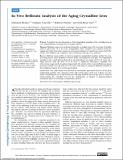| dc.contributor.author | Besner, Sebastien | |
| dc.contributor.author | Scarcelli, Giuliano | |
| dc.contributor.author | Pineda, Roberto | |
| dc.contributor.author | Yun, Seok Hyun (Andy) | |
| dc.date.accessioned | 2017-05-05T17:42:49Z | |
| dc.date.available | 2017-05-05T17:42:49Z | |
| dc.date.issued | 2016-10 | |
| dc.identifier.issn | 1552-5783 | |
| dc.identifier.uri | http://hdl.handle.net/1721.1/108704 | |
| dc.description.abstract | Purpose: To analyze the age dependence of the longitudinal modulus of the crystalline lens in vivo using Brillouin scattering data in healthy subjects.
Methods: Brillouin scans were performed along the crystalline lens in 56 eyes from 30 healthy subjects aged from 19 to 63 years. Longitudinal elastic modulus was acquired along the sagittal axis of the lens with a transverse and axial resolution of 4 and 60 μm, respectively. The relative lens stiffness was computed, and correlations with age were analyzed.
Results: Brillouin axial profiles revealed nonuniform longitudinal modulus within the lens, increasing from a softer periphery toward a stiffer central plateau at all ages. The longitudinal modulus at the central plateau showed no age dependence in a range of 19 to 45 years and a slight decrease with age from 45 to 63 years. A significant intersubject variability was observed in an age-matched analysis. Importantly, the extent of the central stiff plateau region increased steadily over age from 19 to 63 years. The slope of change in Brillouin modulus in the peripheral regions were nearly age-invariant.
Conclusions: The adult human lens showed no measurable age-related increase in the peak longitudinal modulus. The expansion of the stiff central region of the lens is likely to be the major contributing factor to age-related lens stiffening. Brillouin microscopy may be useful in characterizing the crystalline lens for the optimization of surgical or pharmacological treatments aimed at restoring accommodative power. | en_US |
| dc.description.sponsorship | National Institutes of Health (U.S.) (R01EY025454) | en_US |
| dc.description.sponsorship | National Institutes of Health (U.S.) (R21EY023043) | en_US |
| dc.description.sponsorship | Harvard Catalyst (UL1-RR025758) | en_US |
| dc.description.sponsorship | National Science Foundation (U.S.) (CBET-1562863) | en_US |
| dc.description.sponsorship | National Science Foundation (U.S.) (CMMI-1537027) | en_US |
| dc.description.sponsorship | Massachusetts General Hospital. Research Scholar Award Program | en_US |
| dc.language.iso | en_US | |
| dc.publisher | Association for Research in Vision and Ophthalmology | en_US |
| dc.relation.isversionof | http://dx.doi.org/10.1167/iovs.16-20143 | en_US |
| dc.rights | Creative Commons Attribution-NonCommercial-NoDerivs License | en_US |
| dc.rights.uri | http://creativecommons.org/licenses/by-nc-nd/4.0/ | en_US |
| dc.source | Association for Research in Vision and Ophthalmology (ARVO) | en_US |
| dc.title | In Vivo Brillouin Analysis of the Aging Crystalline Lens | en_US |
| dc.type | Article | en_US |
| dc.identifier.citation | Besner, Sebastien et al. “In Vivo Brillouin Analysis of the Aging Crystalline Lens.” Investigative Opthalmology & Visual Science 57.13 (2016): 5093. | en_US |
| dc.contributor.department | Harvard University--MIT Division of Health Sciences and Technology | en_US |
| dc.contributor.mitauthor | Yun, Seok Hyun (Andy) | |
| dc.relation.journal | Investigative Opthalmology & Visual Science | en_US |
| dc.eprint.version | Final published version | en_US |
| dc.type.uri | http://purl.org/eprint/type/JournalArticle | en_US |
| eprint.status | http://purl.org/eprint/status/PeerReviewed | en_US |
| dspace.orderedauthors | Besner, Sebastien; Scarcelli, Giuliano; Pineda, Roberto; Yun, Seok-Hyun | en_US |
| dspace.embargo.terms | N | en_US |
| mit.license | PUBLISHER_CC | en_US |
